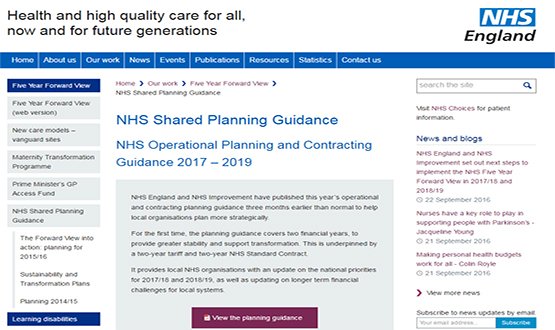Framework for debate

The National Information Board is playing an increasingly central role in NHS IT in England; as shown by the constant mentions of its forthcoming IT strategy at EHI Live 2014.
The long-awaited and much-delayed strategy for the use of data and information in the health service is due to be released on Thursday, as long as the Department of Health can finalise a “major” speech on technology by health secretary Jeremy Hunt.
Originally scheduled for release last December, the plan has been pushed back several times as NHS England, the Health and Social Care Information Centre and other health bodies plotted out the finer details.
However, opening the show in Birmingham, NHS England’s national director of patients and information Tim Kelsey was keen to present the document as a turning point for IT in the NHS.
“I am optimistic. The NHS is speaking with a single voice on how to build the future, and that is a new tone on what we have had before,” he told his audience. “The digital revolution is upon us. We must embrace it.”
Bridging the gap
Kelsey, who also chairs the NIB, promised the plan would address the recently released ‘Five Year Forward View’, which sets out to explain how the £30 billion funding gap that could open up between NHS funding and demand by 2020-21 can be bridged.
The plan calls for a big push on public health to help damp down demand, and for new, more efficient models of healthcare, with an emphasis on integration and information-sharing. Speakers following in Kelsey’s wake were keen to share his confidence about the impact of this week’s framework.
Andy Williams, the chief executive of the Health and Social Care Information Centre, spoke about “a revolution coming” in health IT and said it will provide a guiding light at a national level while not stifling local innovation.
“This is not top down: this is about what we need to do nationally, but also what we need to do to enable things to happen locally.”
Will Cavendish, the Department of Health’s director general of innovation, growth and technology, said a digital transformation, aided by the framework, is “absolutely crucial to a high-quality health and social care system that delivers great care within budget.”
He added: “There are challenges to be faced, but I think it's an increasingly exciting and increasingly important time.”
From rhetoric to results
Of course, while the document is sure to outline a wondrous vision of health IT and its use within the NHS, transforming those ideals into reality is another matter altogether.
First, the twin pitfalls of bureaucracy and managing implementations and contracts must be navigated, perhaps best demonstrated by the presentations from Beverley Bryant and Mary Barber.
Bryant, NHS England’s director of strategic systems and technology, had to apologise to her audience for the delay in announcing which trusts have secured grants from the second round of NHS England’s technology fund.
Saying she was “beyond sorry” for the delay, Bryant betrayed some frustration with the process when she spoke about “clearing the walls” of NHS England and the Department of Health, only for final sign-off to be stuck with the office of the chief secretary to the Treasury.
Another burden on Bryant’s mind is managing the huge block of trusts going out to market for new systems in response to the end of the National Programme for IT’s contracts in the North, Midlands and East.
Barber, the HSCIC’s CSC local service provider programme director, outlined the array of risks facing trusts moving off their LSP contracts, with the transition set to unleash significant demand for systems that suppliers might struggle to meet.
While NHS England and the HSCIC are working on a number of initiatives to manage the risk, such as supporting the NHS Shared Business Service framework, Barber was not shy about outlining the scale of the task ahead.
“I have been involved in change management for many years and if I really thought about this I would not sleep at night,” she said, adding that they only way forward was for trusts to work together as much as possible, to make sure that not only the “headline” grabbing organisations ended up with the IT they need.
The Welsh way
Andrew Griffiths may not be involved in the development of the NIB framework, but the chief information officer of the NHS Wales Informatics Service provided a good summary of the challenges facing NHS England as he spoke about his organisation’s own work on a strategy refresh.
“People are fed up with strategies that keep saying a lot of the same things when we need to get on with doing things,” he said. “That's the big challenge for us: how do we move out of the talking phase and into the doing phase?”
Wales is trying its best to do, rather than talk. As Griffiths told those at the show, Wales’ smaller size and devolution has allowed it to take a planned approach to healthcare where England has turned to a market-driven focus, delivering a national vision. “We can all get in one room, and that’s both a strength and weakness on occasion.”
The organisation is in the middle of a technology revamp: it recently deployed a laboratory information management system and is out for tender on a single community care information solution to integrate social care, community health and mental health services across Wales.
It is also working on expanding the Welsh Clinical Portal, intended to provide universal access to patient information; and the Individual Health Record, what Griffiths describes as the “much richer” Welsh equivalent of NHS England’s Summary Care Record.
Despite the positives of the national approach in Wales, Griffiths was quick to address the spectres of England’s NPfIT and what many saw as its overly prescriptive approach to systems implementations.
“Plenty of people think that if the devil was to walk upon the earth, he would be pushing national systems. I'm not talking about a national approach in terms of top-down bureaucracy, but a recognition that we need to work across boundaries for the benefit of patients.”
Power to the people
Before health and care organisations can use patients’ data for their benefit, they must first gain their trust that their information will not be used in an inappropriate way.
Privacy concerns featured strongly in speakers’ presentations, with all involved keen to acknowledge that they have learned their lessons from the outcry over the care.data programme and how patient data was to be used.
Williams said a key issue for the HSCIC, and for all health IT leaders, is addressing concerns about information governance and data privacy so patients understand why and how their information will be shared and are happy for it to be put to use.
“If we believe that we’re going to make the system better, and that a lot of that is to do with sharing information and passing it around more freely…we have to earn the right to use it for the benefit of patients.”
Cavendish was also clear about the importance of winning over the public, and the high stakes at play if their trust is not secured. “We need to bridge the gap in taking the public’s consent with us to a world where health data is protected but is available when clinicians need it. If we get it wrong, we will face a lot of work and effort to get back on track again.”
Kelsey said the NIB strategy will tackle the issue of trust, with an expansion of the audit data in the My NHS section of NHS Choices, and new audit trails to show people who had accessed their health records and what they had done with the information.
A long winter, or an early spring?
It is clear that those at the highest levels of health IT are placing a great deal of stock in the NIB framework to address the issues that have dogged them for a long time, while simultaneously rising to the opportunities that Kelsey’s information revolution will bring.
As Cavendish noted, IT’s status as a Cinderella service within the NHS is well overdue for a transformation. “Too often IT has been treated as a back office function, but we must always integrate it into the way medics and clinicians make treatment decisions, rather than treating it as an add-on.”
As the mist rose off scenic Pendigo Lake while EHI Live attendees walked to the NEC, the chill in the air made it apparent that winter is on its way.
Kelsey and company will hope that the release of the strategy harkens an early spring full of innovation, integration and collaboration between NHS trusts and the health and social care sector, as the “information revolution” is harnessed to its full potential.
If they fail to meet expectations, or translate rhetoric into results, it could prove to be a long winter for IT in the NHS.



